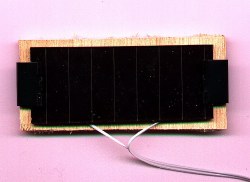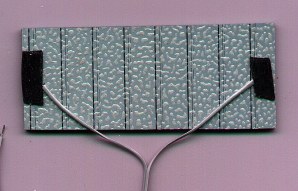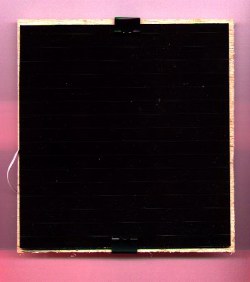| Assembling DIY Solar Panels |
| The material used for our panels is amorphous silicon 'glass' and it can usually be treated just like glass except for the special rear thin coating to which leads are attached. In our small kits it has been 'cut' into 6" squares and arrives with steel clips, thin flex, etc along with a small sample assembled panel (as on right). This sample shows the size required for most 3v radios which is cut, as with ordinary glass, from a larger piece. The picture below shows how simple this technique can be! The ends of a flex are bared and held to the 'glass' rear with tape, etc after scraping away the tin plastic coating over a metal film. An even cheaper alternative, where plywood is unobtainable, is also available. Obviously, there are far better ways of making solar panels, which we explain in our instructions sent with kits, but here we try to show how virtually ANYONE can have a simple solar panel to power their radio for very little indeed! A 6" square is enough for most 6v radios. If a larger panel is used, it does no harm to the radio but is obviously wasting solar material! |
  |
|
| For radio/cassettes the size of solar panel required is indicated in the instructions sent along with other useful information. The picture opposite shows a 6" square which will power most 6v cassettes. Since not only the voltage but the power required varies from set to set, getting the right size of panel needs some thought. If too large, there is no danger only unnecessary wastage of 'glass'! Where people can afford NiCds to go in the battery compartment and store, there is normally no problem. If the set consumes more power than normal, the NiCds need more frequent solar charging. |
 |
|
| Special Conditions The panel assembly technique above is the simplest low-cost method that we can devise for initial use and works well in most conditions. However under damp conditions other techniques are more reliable and we send details as required. This solar technique, though aimed at developing countries, is sold to anyone interested in DIY. However it must be appreciated that solar electricity is rarely suitable in damp, cloudy climates and certainly needs a considerable assembly effort if electricity is required for more than just powering a radio. |
 |
Home Page